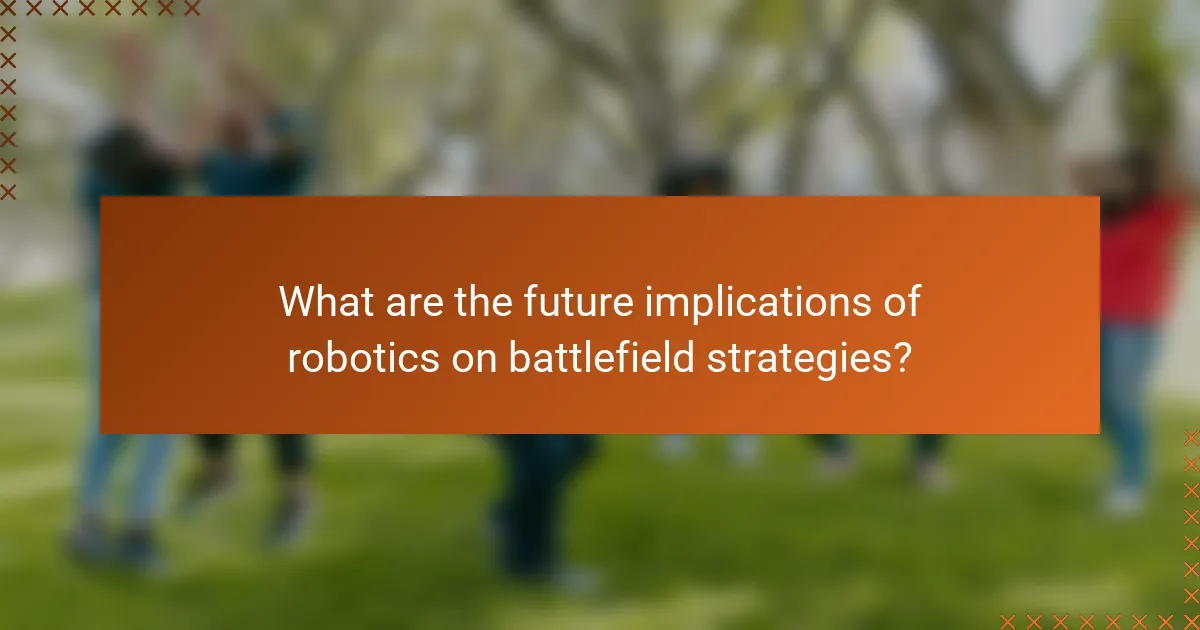Robotics plays a crucial role in transforming battlefield tactics and strategies by improving operational efficiency and decision-making. Autonomous systems, including drones and robotic ground vehicles, enhance surveillance, reconnaissance, and logistics, thereby minimizing risks to personnel. These technologies enable real-time intelligence gathering and precise target engagement, leading to faster response times and reduced collateral damage in military operations. The integration of robotics into warfare facilitates remote engagement, shifting the focus from manpower to technological capabilities. As military strategies evolve, the use of robotics is becoming increasingly standard among modern armed forces, highlighting its significant impact on the future of combat.

What is the Influence of Robotics on Battlefield Tactics and Strategies?
Robotics significantly influences battlefield tactics and strategies by enhancing operational efficiency and decision-making. Autonomous systems can perform surveillance, reconnaissance, and logistics, reducing human risk. Drones, for instance, provide real-time intelligence and can engage targets with precision. The integration of robotics allows for faster response times in combat scenarios. Studies show that robotic systems improve accuracy and reduce collateral damage in military operations. Furthermore, robotics can facilitate remote warfare, allowing operators to engage from safe distances. This shift alters traditional combat strategies, emphasizing technology over manpower. The use of robotics in warfare is increasingly becoming a standard practice among modern militaries.
How have robotics evolved in military applications?
Robotics in military applications have evolved significantly over the past few decades. Initially, military robotics focused on simple remote-controlled devices for surveillance and bomb disposal. The introduction of drones marked a pivotal shift, enabling real-time aerial reconnaissance and targeted strikes. By the early 2000s, unmanned ground vehicles were deployed for logistics and reconnaissance missions. Advanced AI integration allowed for autonomous decision-making in complex environments. Today, robotics enhance battlefield tactics through swarm technology, where multiple drones coordinate for strategic advantages. The U.S. military’s Project Maven exemplifies this evolution, utilizing AI to analyze drone footage for actionable intelligence. This progression demonstrates robotics’ growing role in modern warfare, enhancing operational efficiency and reducing human risk.
What are the key advancements in robotic technology for warfare?
Key advancements in robotic technology for warfare include autonomous drones, robotic ground vehicles, and advanced AI systems. Autonomous drones can carry out surveillance and strike missions without direct human control. These drones enhance operational efficiency and reduce risks to human life. Robotic ground vehicles are used for logistics, reconnaissance, and bomb disposal. They improve safety by performing dangerous tasks remotely. Advanced AI systems enable real-time data analysis and decision-making. These systems increase the speed and accuracy of military operations. Collectively, these advancements transform battlefield tactics and strategies, allowing for more precise and effective engagements.
How do these advancements impact battlefield efficiency?
Advancements in robotics significantly enhance battlefield efficiency. Robotics improve operational speed and precision in military engagements. They reduce human error by executing tasks with high accuracy. Unmanned systems can gather intelligence without risking lives. This capability allows for quicker decision-making in dynamic environments. Robotics also enable logistical support, streamlining supply chains and reducing delays. Studies show that integrating robotics can lead to a 30% increase in mission success rates. The effectiveness of robotic systems is evident in recent military operations, where they played crucial roles in surveillance and reconnaissance.
What roles do robots play in modern warfare?
Robots play multiple roles in modern warfare, significantly enhancing military capabilities. They are utilized for surveillance, reconnaissance, and intelligence gathering. Unmanned aerial vehicles (UAVs), commonly known as drones, provide real-time aerial footage. Ground robots are deployed for bomb disposal and logistical support. Autonomous systems can conduct search and rescue missions in hazardous environments. Additionally, robots assist in training simulations for soldiers. The integration of robotics improves operational efficiency and reduces human risk. Reports indicate that UAVs have been pivotal in recent conflicts, showcasing their effectiveness in combat scenarios.
How are unmanned aerial vehicles (UAVs) utilized in combat?
Unmanned aerial vehicles (UAVs) are utilized in combat primarily for surveillance, reconnaissance, and targeted strikes. UAVs provide real-time intelligence by capturing high-resolution images and video. They can operate in hostile environments without risking human lives. UAVs enhance situational awareness for ground forces and commanders. They are equipped with advanced sensors for detecting enemy movements. UAVs also conduct precision strikes with minimal collateral damage. The use of UAVs has increased in modern warfare, with notable deployments in conflicts such as Afghanistan and Iraq. Their effectiveness is demonstrated by their ability to gather data and engage targets efficiently.
What is the significance of ground robots in troop support?
Ground robots are significant in troop support as they enhance operational efficiency and safety. These robots can perform reconnaissance, logistics, and explosive ordnance disposal. They reduce the risk to human soldiers by taking on dangerous tasks. For instance, the U.S. Army’s Robotic Combat Vehicle program aims to integrate unmanned systems into combat operations. Studies show that ground robots can increase mission success rates while minimizing casualties. Their use in various military exercises has demonstrated improved situational awareness. Additionally, they facilitate communication and coordination among troops. Ground robots represent a transformative shift in modern warfare strategies.

How do robotics change traditional battlefield tactics?
Robotics significantly change traditional battlefield tactics by enhancing operational efficiency and situational awareness. They enable remote surveillance and reconnaissance, reducing risks to personnel. Drones and robotic ground vehicles can gather intelligence in real-time. This capability allows for quicker decision-making and response times. Robotics also facilitate logistics and supply chain management, ensuring timely delivery of resources. Automated systems can perform tasks such as explosive ordnance disposal and medical evacuation. Historical examples include the use of unmanned aerial vehicles in conflicts like Iraq and Afghanistan. These advancements illustrate a shift from manned to unmanned operations, transforming engagement strategies.
What tactical advantages do robots provide on the battlefield?
Robots provide several tactical advantages on the battlefield. They enhance reconnaissance capabilities by gathering intelligence without risking human lives. Autonomous drones can cover large areas quickly, providing real-time data. Robots also excel in logistics, transporting supplies efficiently to frontline troops. Their use in explosive ordnance disposal reduces the risk of casualties from landmines and IEDs. Additionally, robots can operate in hazardous environments, such as chemical or nuclear zones, where human soldiers would be at risk. The integration of robotics increases operational efficiency and effectiveness in military operations. These advantages contribute to a strategic edge in modern warfare scenarios.
How do robots enhance reconnaissance and surveillance operations?
Robots enhance reconnaissance and surveillance operations by providing real-time data collection and analysis. They can access hard-to-reach areas without risking human lives. Equipped with advanced sensors, robots can capture high-resolution imagery and monitor environmental conditions. This capability allows for improved situational awareness in various terrains.
For example, drones can cover large areas quickly, reducing the time needed for intelligence gathering. Ground robots can navigate through complex environments, providing detailed information on enemy positions. The use of robots also minimizes the risk of detection, as they can operate quietly and discreetly.
Studies have shown that robotic systems significantly increase the effectiveness of surveillance missions. According to a report by the U.S. Army Research Laboratory, robots can enhance operational efficiency by up to 30% in reconnaissance tasks. This data underscores the critical role robots play in modern military operations.
What is the role of automation in decision-making during combat?
Automation plays a critical role in decision-making during combat by enhancing situational awareness and response times. Automated systems analyze vast amounts of data quickly. They process information from various sensors and intelligence sources. This capability allows for faster identification of threats and opportunities. Automation reduces the cognitive load on human operators. It enables them to focus on strategic decision-making rather than routine tasks. For instance, drones equipped with automated targeting systems can engage targets with precision. Studies have shown that automation can improve mission success rates by up to 30%. This efficiency is vital in high-pressure combat scenarios where time is of the essence.
In what ways do robots affect the dynamics of warfare?
Robots significantly affect the dynamics of warfare by enhancing operational efficiency and reducing human risk. They can perform reconnaissance missions, providing real-time intelligence without endangering soldiers. Unmanned aerial vehicles (UAVs) have been used extensively for surveillance and targeted strikes, increasing precision in combat. Ground robots can clear mines and perform logistics tasks, streamlining supply chains on the battlefield. The integration of artificial intelligence allows for faster decision-making processes in combat scenarios. Data from the U.S. Department of Defense indicates that robotic systems have improved mission success rates by up to 30%. Additionally, the use of robots can lead to ethical concerns regarding autonomous weaponry and accountability in warfare.
How do robots alter enemy engagement strategies?
Robots alter enemy engagement strategies by introducing automation and unpredictability in combat scenarios. Their deployment allows for real-time data collection and analysis, enhancing situational awareness. This capability forces adversaries to adapt their tactics to counter robotic systems. For example, drones can conduct surveillance and strike missions, compelling enemies to invest in counter-drone technologies. Additionally, robots can operate in hazardous environments, reducing risk to human soldiers. This shift influences decision-making processes on the battlefield, as enemies must consider the presence of robotic units in their strategic planning. Historical instances, such as the use of unmanned aerial vehicles in modern conflicts, demonstrate how robots have reshaped engagement dynamics.
What psychological impacts do robotic forces have on soldiers?
Robotic forces can significantly impact soldiers’ psychological well-being. The presence of robotic systems may reduce the stress associated with direct combat. Soldiers often feel a sense of detachment when robots perform dangerous tasks. This detachment can lead to decreased emotional trauma from combat experiences. However, reliance on robotic forces may also cause feelings of inadequacy among soldiers. Some may perceive themselves as less capable or necessary in the battlefield. Research indicates that soldiers may experience anxiety about the effectiveness of robotic systems. Studies show that the unpredictability of robots can lead to increased stress levels. Overall, the psychological impacts are complex and multifaceted, influencing soldiers’ mental health in various ways.

What are the future implications of robotics on battlefield strategies?
The future implications of robotics on battlefield strategies include enhanced operational efficiency and reduced human risk. Robotics will enable real-time data analysis and decision-making. Autonomous drones can conduct surveillance and engage targets without human intervention. This capability may lead to faster response times in combat situations. Additionally, robots can perform logistics and supply chain functions, optimizing resource allocation. Research indicates that integrating robotics can reduce casualties by minimizing human involvement in dangerous tasks. A study by the RAND Corporation highlights that robotic systems could change the nature of warfare, emphasizing speed and precision. As robotics technology advances, these systems will likely become integral to military strategies worldwide.
How might robotics shape future military doctrines?
Robotics will significantly influence future military doctrines by enhancing operational efficiency and decision-making capabilities. Autonomous systems can conduct surveillance, reconnaissance, and logistical support, reducing the risk to human soldiers. The integration of robotics allows for real-time data analysis, facilitating quicker strategic responses. Drones and unmanned ground vehicles can be deployed for precision strikes, minimizing collateral damage. Additionally, robotics can enable remote warfare, allowing forces to engage adversaries from a safe distance. Historical examples, such as the use of drones in conflicts like Afghanistan, demonstrate the effectiveness of robotic systems in modern warfare. As technology advances, military doctrines will increasingly incorporate robotics to maintain a strategic advantage.
What are potential ethical considerations in using robots in combat?
Potential ethical considerations in using robots in combat include accountability, decision-making, and civilian safety. Accountability issues arise when determining who is responsible for actions taken by autonomous systems. The lack of human oversight can lead to challenges in attributing blame for mistakes or unlawful acts. Decision-making by robots raises concerns about the ability to make moral judgments in complex situations. Robots may not fully comprehend the nuances of human life and ethical dilemmas. Civilian safety is another critical consideration, as robotic systems may struggle to differentiate between combatants and non-combatants. This can increase the risk of collateral damage. Additionally, the use of robots may desensitize soldiers to violence, as they engage in combat without direct human involvement. These ethical considerations reflect the complexity of integrating robotics into military operations.
How can military training evolve to incorporate robotic systems?
Military training can evolve to incorporate robotic systems by integrating them into simulation exercises. These simulations can mimic real-world scenarios where robots assist soldiers. Training programs should include hands-on experience with robotic systems to enhance familiarity. Additionally, curricula must cover the strategic use of robots in various combat situations. Incorporating robotics into decision-making training is essential. This prepares personnel to utilize robots effectively in the field. Research shows that militaries using robotic systems improve operational efficiency. A study by the U.S. Army indicated that robotic assistance can reduce casualties and enhance mission success rates.
What best practices should be considered when integrating robotics into military operations?
Best practices for integrating robotics into military operations include ensuring interoperability, establishing clear command and control protocols, and prioritizing cybersecurity measures. Interoperability allows robotic systems to work seamlessly with existing military assets. Clear command and control protocols are essential for effective decision-making and coordination during operations. Cybersecurity measures protect robotic systems from potential threats and vulnerabilities. Training personnel to operate and maintain these systems is also critical for successful integration. Additionally, ongoing evaluation and adaptation of robotic technologies ensure they meet evolving battlefield requirements. These practices enhance operational efficiency and effectiveness in military contexts.
The main entity of this article is robotics and its influence on battlefield tactics and strategies. The article explores how robotics enhances operational efficiency, decision-making, and reduces human risk in military operations. Key advancements such as autonomous drones and robotic ground vehicles are discussed, highlighting their roles in surveillance, reconnaissance, and logistics. The impact of these technologies on traditional combat strategies, mission success rates, and ethical considerations are also examined, providing a comprehensive overview of the evolving dynamics of warfare. Additionally, the article outlines future implications and best practices for integrating robotics into military operations.